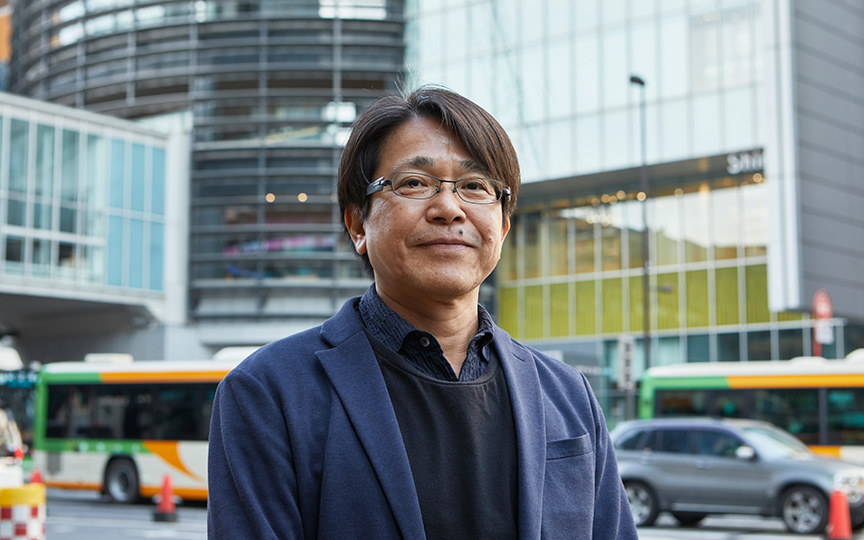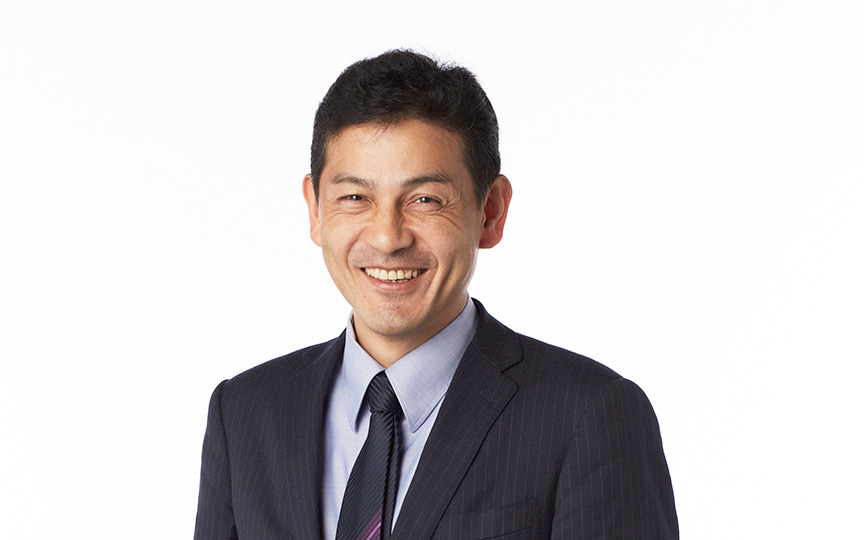“Human Motion”and “Diversity on the Streets” Connected with the Urban Core (Part II)
Scroll Down
Today, the streets of Shibuya have become the stage for large-scale redevelopment. Here to talk about Shibuya’s redevelopment projects are Kazuko Akamatsu (right), design architect at Coelacanth and Associates for the opening of Shibuya Stream (also simply known as “Stream”) in 2018, and Shigeru Yoshino (left), designer for “Shibuya Hikarie” (also known as “Hikarie”), constructed in 2012, ushering in the dawn of redevelopment. The keyword here is “urban core”, a base for vertical movement connecting the underground with that above, installed in each block in a single line of flow. What is the shape of the future of Shibuya as seen from these two facilities and two urban cores? Facilitator Kiyoyoshi Okumura, representing Nikken Sekkei’s Urban Development Planning Group, has extensive experience in a number of urban development projects both in Japan and overseas and has been involved in the redevelopment movement in Shibuya since the formulation of community development guidelines for the central area of Shibuya Station.
TAG
Bringing the urban character of Shibuya into new building designs
Akamatsu: In the past, when I was given an assignment based on Shibuya at graduate school, the students first researched the central area, and I felt that the area on the south side of Shibuya Station was not really recognized as part of Shibuya. Divided by Rt. 246 and the metropolitan expressway gives each area its own unique characteristics, but dynamic mobility is still needed. Redevelopment that does not homogenize the entire city is an important aspect and I think that this is going on right now in Shibuya.
Yoshino: One of the ways to do this is to give the urban core a unique quality that becomes the symbol of a city block.
Akamatsu: Yes. Next then would be the phase of how to connect them. It will be very interesting to connect each area through an urban core, while also establishing the individuality of each block.
Yoshino: Stream will be connected to the Sakuragaokaguchi area in the future, correct?
Akamatsu: Nobuaki Furuya, a design architect for the Sakuragaokaguchi area, fine tunes designs through the design meetings. For example, when you change trains, there are places where there are just no roofs. People wonder why they need to put up an umbrella just for a few moments (laughs). In the case of Shibuya, there should be design meetings that can allow such issues to be resolved through coordination between areas. I think that there are no examples of redevelopment where each area is connected, while maintaining the unique characteristics of these areas, so I hope this will work out well in the future.
 Shibuya Hikarie
Shibuya Hikarie
Akamatsu: Is that way of thinking reflected in Hikarie?
Yoshino: Yes. Hikarie connects the elements of the city vertically like building blocks. It also includes offices, a theater, event hall and shops, so it is possible to have an integrated design, but I think that it would not be impossible for it to be divided according to application. It is a great idea to create a section that is mixed while also being segmented in this way and to connect it with elevators. Stream has a distinctive appearance. What type of concept is this?
Akamatsu: In the case of a high-rise building, the shape of the top of the building is determined to some extent by the perspective of business or commercial activities. So, first we thought of the space at our feet. How could we keep the tracks of the Toyoko line in people’s heads? How could we match the feeling of scale of residential buildings and alleys in the city of Shibuya that are clustered so close to each other. In order to avoid the sure feeling of locating the entrance to the building, we installed a porous (hole) connecting the inside and outside of the lower floors, which gives the image that a road is passing directly through the building.
 Shibuya Stream/From Shibuya Hikarie, Inari Bridge Square, 2F Stream Line
Shibuya Stream/From Shibuya Hikarie, Inari Bridge Square, 2F Stream Line
Akamatsu: We thought about and studied the idea of using a façade with various functions, not just wrapping. Although we were not able to completely achieve all of our ideas, we repeatedly went back to ideas on how to allow natural breezes to flow in, how to shield sunlight, and how to apply this to the environment and structure. Next, we thought about how it would blend in with other buildings over the course of redevelopment in the future. We had extensive discussions on how to connect what we saw at our feet from a human scale to the upper floors of the building at the city scale.
Okumori: At Nikken Sekkei, we are discussing what to do about the Shibuya River at the master plan stage. The Nikken Sekkei team is helping to design the space along the Shibuya River. The design captures the river in a three-dimensional space and uses gutters as benches and tables for an industrial-type design.
Akamatsu: From the very start of the story on this project, I have been aware of the existence of the Shibuya River. In fact, our office was once located along the Shibuya River. We were in a small building on a site like a thin slice between Meiji-dori and the Shibuya River. When I was still new to the office, I remember that I brought a floodlight to the revetment of the river to shoot photos for a magazine and took guerrilla-style photos (laughs). Since then, Shibuya has become a glamorous city, but I have always thought that the voids of the city, like the Shibuya River, are the real figures of the city.

Interweaving small projects for large-scale development
Yoshino: When I was a student in Shibuya and came down from Dogenzaka to the station, it was somewhat dirty (laughs). It was also a pain to go up the stairs and take the train, so from my late thirties, I pretty much stopped going there. But, with the completion of Shibuya Mark City and the cool gate of metal panels leading to Dogenzaka, it became easier to go out of the main Tokyu store and I started to come to Shibuya again. With Hikarie, people can also walk in the direction of Omotesando as they travel through the urban core. Even without huge structures or smaller paths, I think that there will be a flow of traffic if they can be connected.
Akamatsu: Hikarie is connected to Aoyama and Stream is connected to Ebisu and Daikanyama. If a well-colored background and unique features can be used, it will be compatible in terms of both fun and convenience by connecting the entire area of Shibuya.
Yoshino: There aren’t very many cities that have changed as much as Shibuya, are there? As we get older in our 20s, 30s, and 40s, I have a strong feeling that it is going to continue to change and becoming an even more alluring city.
Okumori: What are both of your expectations for the future of Shibuya or what projects would you like to be involved in?
Yoshino: Even as the face of Shibuya shifts, it seems that the JR stations have not yet changed. Design architects Nikken Sekkei, Kengo Kuma, and Kazuyo Sejima are involved in the design for the Shibuya Scramble Square, which includes stations, and I believe that the station facilities that will be part of Phase 2 will probably be discussed at the design meetings in the future. For example, rather than a building design, I would be more interested in creating designs with a more human touch, such as setting up a design for a platform or ticket gate.

Yoshino: Rather than an “at-home” feel, you are looking more at accommodation facilities where people can stay temporarily?
Akamatsu: Small-scale, like having places above shops where people can stay for a while or having young people setting up an atelier while working. If there are well-circulated systems in place when the rent is high because of its prime location…If small, old buildings can be properly renovated, they can fit into the gaps between large-scale development.
Yoshino: It seems that a movement is afoot to convert slender, “pencil”-like buildings built along the Shibuya River. I would also like to be involved in this. There are a lot of unique shops around the Shibuya River. Even though it’s a ramen shop, it turns into a bar when you go up through the back door. There are also buildings used to film movies and offices where animators get together…
Akamatsu: That thin section between Meiji-dori and the Shibuya River may actually be important. I think that there will be few opportunities for skyscrapers in the future, so people should speak out if they have small, interesting jobs available in the Shibuya area (laughs).
Okumori: It is also extremely important to discuss how to incorporate designs that cannot be moved simply with logical capital. Of course, collaboration between various projects, large and small, as well as the two complete urban cores, will pave the way to a newly-rejuvinated Shibuya. I hope that we can continue to have discussions on these points in the future. Thank you both very much for your time today.

Kazuko Akamatsu
CAt Partner
Professor, Hosei University / Part-time lecturer, Kobe Design University

Shigeru Yoshino
Executive
Design Fellow
